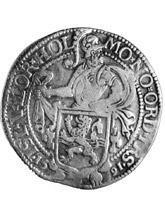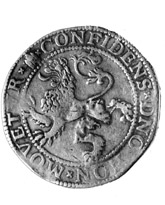
Dutch "Leeuwendaalder" minted in the Province of Overijssel, 1591. The obverse depicts a knight in armor, with the provincial arms on shield.
The coin collection of the Israel Antiquities Authority possesses fifty-three silver lion dollars (‘leeuwendaalders’) of the Low Countries dating to the 16 and 17th century. These coins belong to two hoards, which were deposited at the Rockefeller Museum in the late 1920's but never properly identified and studied.
A search in the files of the Coin Department dating back to the British Mandate period allowed a reconstruction of the details surrounding the provenance of the two hoards. The first hoard comprised of thirty-one coins and was found in December 1927 by villagers among a small heap of stones in an open valley near the Arab village of Tarshiha, in the Western Galilee. The second hoard comprised of twenty-four coins and was reportedly concealed in a sealed pot discovered in September 1928 by two Arab workmen in a cave at the artificial mound of Tel el-Jarishe near the coastal city of Tel-Aviv which was then being excavated.
Despite their wide circulation in the Eastern part of the Ottoman Empire during the seventeenth and eighteenth centuries, few finds of Leeuwendaalders have been recorded in detail. Their publication therefore constitutes a valuable addition to our knowledge about the role this particular coinage played in the Eastern Mediterranean during the 16th—18th century.

On its reverse a Lion rampant ('attacking') with the Latin motto: Confidens Domino non movetur, "Confidence in the Lord is not moved".
The lion dollar was originally introduced as a war currency at the start of the Eighty Year’s War between the Nothern Dutch provinces and Spain. In 1575 the Province of Holland issued the silver Leeuwendaalder for the first time to mobilize funds against the invading Spanish armies threatening to crush their rebellion against Spanish overlordship. To underline the break with Spanish sovereignty the Provinces replaced the portrait and coat of arms of the Spanish monarch, Philip II, with a lion rampant (obverse) and knight in armor (reverse). This type was based on the popular Joachimstaler from Schlick in Bohemia. Initially the new Dutch coin minted with 75% silver content was overvalued by decree above its intrinsic value, allowing the United Netherlands a profit of 10% to finance their war efforts.
During the last two decades of the 16th century the coin gained a dominant position in the Netherlands. For the first time new issues were struck specifically for trade with the Baltic sea states, but were soon replaced by the Rijksdaalder as trading currency in this region.
Lion dollars were also extensively used in the developing trade of the Dutch provinces with the Ottoman Empire from the 1590's onwards. Simultaneously with their retraction from circulation in the United Provinces territory after 1620, large quantities of lion dollars were minted nearly exclusively for export to the Middle East. The peak period of production lay between 1630-1690 when the coin began to be extensively used by Dutch French and English trading companies throughout the Mediterranean region. The demand for the coin was so large that it gave rise to numerous imitations: currently we know of more than forty-three Italian and Northern European cities minted imitations of the type during this period.
Lion dollars of the United Provinces were introduced as currency in the Ottoman Empire at the end of the 16th century by Dutch traders before official diplomatic relations existed between the Republic and the Ottoman empire (1612). During the 17th century these Dutch aslandi or esedi (lion) replaced the indigenous Akce. It became the predominant silver currency used in foreign commerce with the Ottomans until the end of the 17th century. With the introduction of a ‘heavy’ Ottoman standard silver coinage (grush or piastre) under Suleiman II (1687-91) it was eventually ousted by the Austrian Maria Theresa thaler and the Spanish pillar dollar during the 18th century.
Significantly, relatively large quantities of these coins, including the Tarshiha hoard, were found in the area that currently constitutes the Northern part of Israel, Syria and Lebanon. This region played an important role as supplier of cotton for Western Europe during the 17th-18th century, in particular to France. It was during the reign of Louis XIV (1648-1720) that the use of cotton for clothing disseminated widely among the privileged classes of Western Europe. Palestinian cotton was very highly regarded and exported with great profits in particular to France. The best quality cotton came from the Galilee and was known in Europe as ‘Coton D'Acre’. During this period the bulk of Palestinian cotton trade was handled by French and Dutch traders from Acre. Growing competition between these two nations pushed traders to establish direct control over cotton production around the villages of the Western Galilee, instead of through the Ottoman authorities in Sidon and Acre. In this process large amounts of leeuwendaalders must have been deposited in this area as traders made direct cash advances to the farmers of cotton-producing villages like Tarshiha, in return for sureties to supply stipulated amounts of cotton. Possibly, reasons of trade also played a role in the deposit of leeuwendaalders at Tel-el-Jarishe. The site, near the Arab village of Jarishe, was situated on the banks of the Yarkon river and served till the 18th century as the area’s major port for small trading vessels. Several kilometers stream upwards at the khan of Ras al-‘Ayin — which had been repaired by the Ottomans in 1571 — it linked up with the principal Ottoman trade route connecting Cairo with Damascus and Jerusalem. Excavation material from other sites like Ottoman period Meiron (Galilee) shows that these coins circulated widely often with low denomination money substitutes like Nuremberger jetons.